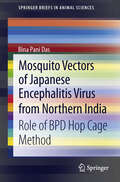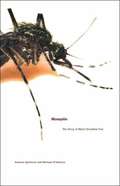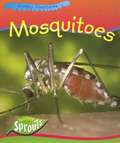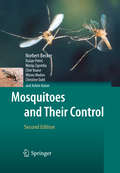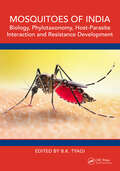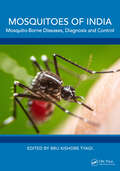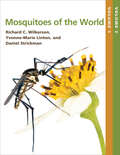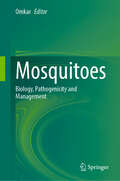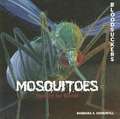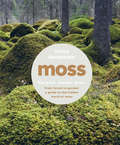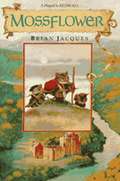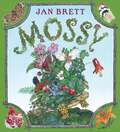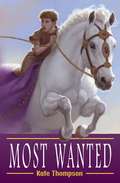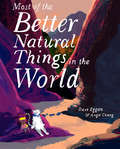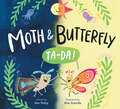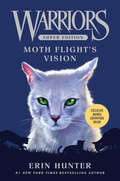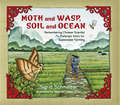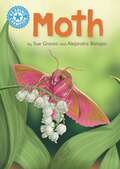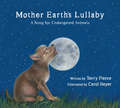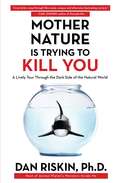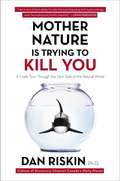- Table View
- List View
Mosquito Vectors of Japanese Encephalitis Virus from Northern India
by Bina Pani DasJapanese Encephalitis (JE), a mosquito borne disease, is the leading cause of viral encephalitis in 14 Asian countries due to its epidemic potential, high case fatality rate and increased possibility of lifelong disability in patients who recover from this dreadful disease. In spite of seriousness of the disease, still only few books are available for ready reference. Hence, this book will be useful for students, entomologists, paramedical staff and vector control managers in public health. The objective of the book is to disseminate the knowledge gained by the author from ecological studies on JE vectors undertaken in 2 endemic and 2 non endemic areas of Northern India over a period of last 15 years (1998-2012) of research in the field of ecology of mosquito vectors of JE virus initially at National Institute of Communicable Diseases (Ministry of Health & Family Welfare, Government of India), Delhi and later at Jamia Millia Islamia, a Central University, Delhi, to anyone who wishes to curtail death of children due to this dreaded disease. Of the thousand suspected JE deaths in India annually, more than 75% is contributed by Northern India wherein disease transmission failed to be explained based on entomological evidence due to inadequate mosquito surveillance tool used in determining JE vector density. In order to overcome the above problem, Dr Bina Pani Das, the author of this book, developed "BPD hop cage method", a simple, cost effective, and operationally feasible surveillance tool specially designed to capture predominantly day resting adult Cx. tritaeniorhynchus mosquitoes, the principal JE vector species in the country from land and aquatic vegetation.
Mosquito: The Story of Man's Deadliest Foe
by Andrew SpielmanNow in paperback--a fascinating work of popular science from a world-renowned expert on mosquitoes and a prize-winning reporter.In this lively and comprehensive portrait of the mosquito, its role in history, and its threat to mankind, Spielman and D'Antonio take a mosquito's-eye view of nature and man. They show us how mosquitoes breed, live, mate, and die, and introduce us to their enemies, both natural and man-made. The authors present tragic and often grotesque examples of how the mosquito has insinuated itself into human history, from the malaria that devastated invaders of ancient Rome to the current widespread West Nile fever panic. Filled with little-known facts and remarkable anecdotes that bring this tiny being into larger focus, Mosquito offers fascinating, alarming, and convincing evidence that the sooner we get to know this pesky insect, the better off we'll be.
Mosquitoes
by Margaret Hall Gail Saunders-SmithFemale mosquitoes suck blood when they bite people and animals. The blood helps them make eggs. Read more about these fascinating bugs in Mosquitoes.
Mosquitoes (Creepy Creatures)
by Sue BarracloughWhat do mosquitoes look like? What do they eat? Where do they live? How are new mosquitoes born? Children love getting a close-up look at fascinating creatures in the world around them. This series allows them to get up close and personal with some of these creepy creatures that they can find in parks, gardens and even their own home. Each book identifies the main physical features of each bug including what they eat, how they change, and how they reproduce.
Mosquitoes and Their Control
by Achim Kaiser Minoo Madon Norbert Becker Marija Zgomba Christine Dahl Clive Boase Dusan PetricMosquitoes and Their Control presents a wealth of information on the bionomics, systematics, ecology, research techniques and control of both nuisance and disease vector mosquitoes in an easily readable style, providing practical guidelines and important information for professionals and laymen alike. Ninety-two European species and more than 100 globally important vector and nuisance species are included in the book. Most of them, including all European species, are described in the fully illustrated identification keys, followed by a detailed description of the morphology, biology, distribution and medical importance of each species, including over 700 detailed drawings. Mosquitoes and Their Control includes: systematics and biology, medical significance, research techniques, illustrated identification keys for larval and adult mosquito general, morphology, ecology, and distribution of the species identified in the keys, biological, chemical, physical and genetic control of mosquitoes. Mosquitoes and Their Control is a valuable tool for vector ecologists, entomologists, and all those involved with mosquito control, biology, ecology, and systematics world-wide. It will especially benefit those professionals, scientists and students dealing with mosquitoes and their control on a day-to-day basis. Society as a whole stands to gain from improved, environmentally responsible mosquito management programs designed on the basis of a broader understanding of mosquitoes and their control, as provided in this enlightening book.
Mosquitoes of India: Biology, Phylotaxonomy, Host-Parasite Interaction and Resistance Development
by B. K. TyagiThis is an up-to-date and comprehensive handbook that presents a wealth of information on the different aspects of one of the largest dipterous family, Culicidae (Mosquitoes). India shares more than ten percent of the global mosquito fauna and this book provides an extensive inventory of extant taxa, along with a detailed description of the key identification features of medically important mosquitoes. This book illustrates updated information on insecticide-based mechanisms of resistance development in vectors and showcases varied host–parasite interactions. This authoritative account is a crucial reference source for mosquito-borne disease control and prevention. This book is meant for researchers, university students, medical entomologists, parasitologists, and public health professionals.
Mosquitoes of India: Mosquito-Borne Diseases, Diagnosis and Control
by Brij Kishore TyagiThis is an up-to-date and comprehensive handbook that presents a wealth of information on the different aspects of one of the largest dipterous family, Culicidae (mosquitoes). India shares more than 10% of the global mosquito fauna and some of the deadliest mosquito species occur in the country, implying that globally, India has always been in the forefront of research and control of such deadly and/or debilitating diseases as malaria, lymphatic filariasis, dengue, chikungunya, Zika, Japanese encephalitis, West Nile Virus, etc. This book illustrates updated information, including chemical, biological, herbal, and genetical, on the control of vectors, and showcases mosquito preponderance in the neighbouring countries. The book additionally deals with the biosafety principles in theory and practice, use of emerging science of artificial intelligence in mosquito identity and control, and, of course, consideration of mosquitoes in human psyche. This authoritative account is a crucial reference source for mosquito-borne disease control and prevention. This book is meant for researchers, university students, medical entomologists, parasitologists, and public health professionals.
Mosquitoes of the World
by Daniel Strickman Richard C. Wilkerson Yvonne-Marie LintonBiting multiple times on two, three, or more different hosts, it is no surprise that some species of mosquitoes have co-evolved with pathogens. For humans and other animals, the result has been some of the most challenging diseases known. It has been said that Anopheles gambiae, as the primary transmitter of malaria parasites to humans, is the most dangerous animal in the world. Certainly malaria has killed more people than all the wars that ever took place. Even now, despite drugs and mosquito control, malaria claims the lives of 405,000 per year. The vast majority of mosquito species are not involved in pathogen transmission to humans, but those that are make a huge impact on global health.In this two-volume set, three of the world's leading experts on mosquito disease, ecology, and systematics offer readers unique insights into the fascinating world of mosquitoes while illustrating their diagnostic morphological features in detail. Comprehensively addressing the natural diversity of mosquitoes, the book explains their life histories, bionomic traits, and the physiological and physical adaptations they evolved in response to ever-changing environmental conditions. Mosquitoes are one of the best-known groups of insects, making this book a great starting place for anyone who would like to understand entomology by knowing the details about a representative family.Volume One contains a review of the biology and diversity of mosquitoes. Biology is treated in the following chapters: • Evolution• Nomenclature• Distribution• Development• Dormancy• Mosquito Movement• Feeding and Nutrition• Excretion• Copulation and Insemination• Egg Development and OvipositionThe chapters on biology are followed by a well-illustrated summary of the characteristics of all 41 genera and of representative species of mosquitoes. This treatment of the morphological diversity of mosquitoes is accompanied by a glossary of all morphological terms used. Volume Two features• a long-awaited comprehensive mosquito taxonomic catalog detailing the current taxonomic and systematic status of all 3,698 valid species and subspecies, 41 genera, and 187 subgenera• a list of all taxa for definitive use of nomenclature• complete lists of species synonyms, distributions, key taxonomic works, and newly defined informal names• origins of scientific namesReaders will discover that some mosquitoes undertake courtship rituals, while others guard their eggs, feed solely on earthworms, or can survive as immatures under ice sheets or in salt-encrusted pools. Hundreds of drawings and high-resolution, close-up images illustrate the text. The most complete reference work on mosquitoes ever produced, Mosquitoes of the World is an unmatched resource for entomologists, public health professionals, epidemiologists, and reference libraries.
Mosquitoes: Biology, Pathogenicity and Management
by OmkarThis book provides a detailed overview of mosquitoes. It covers aspects of their origin, evolution, morphology, diversity, biology, and host finding and recognition. It also describes the behavior and rhythmicity of mosquitoes, their abiotic and biotic interactions, disease vectors and mechanism of disease transmission. Chapters describe mosquito-borne human diseases, mosquito-borne veterinary diseases, and management of mosquitoes. This book provides the readers with both the positive as well as the negative aspects of mosquitoes. It also discusses their use in research as a model organism and development of micro needles and their role in crop pollination. This book is useful for the students studying entomology, public health, medical and veterinary sciences, and applied life sciences. It is also a reference for those working in policy planning and vector management.
Mosquitoes: Hungry for Blood (Bloodsuckers)
by Barbara SomervillYoung readers will be fascinating as they learn how mosquitoes feast on the blood of other animals for nourishment. This engrossing book explores the habitats, hunting patterns, life cycles, and varieties of mosquitoes.
Mosquitopia: The Place of Pests in a Healthy World (Routledge Environmental Humanities)
by MarcusDan Hall TamïrThis edited volume brings together natural scientists, social scientists and humanists to assess if (or how) we may begin to coexist harmoniously with the mosquito. The mosquito is humanity’s deadliest animal, killing over a million people each year by transmitting malaria, yellow fever, Zika and several other diseases. Yet of the 3,500 species of mosquito on Earth, only a few dozen of them are really dangerous—so that the question arises as to whether humans and their mosquito foe can learn to live peacefully with one another. Chapters assess polarizing arguments for conserving and preserving mosquitoes, as well as for controlling and killing them, elaborating on possible consequences of both strategies. This book provides informed answers to the dual question: could we eliminate mosquitoes, and should we? Offering insights spanning the technical to the philosophical, this is the “go to” book for exploring humanity’s many relationships with the mosquito—which becomes a journey to finding better ways to inhabit the natural world. Mosquitopia will be of interest to anyone wanting to explore dependencies between human health and natural systems, while offering novel perspectives to health planners, medical experts, environmentalists and animal rights advocates.
Moss: From Forest To Garden: A Guide To The Hidden World Of Moss
by Ulrica NordströmDiscover the secrets of moss Unassuming yet beautiful, moss has been used for centuries in gardens, medicine, and handicrafts around the world. It is most often associated with damp, shady spaces, but can be found in the most unexpected and far-flung places in the world, from deserts to Antarctica. Moss is Swedish writer and plant artist Ulrica Nordström’s celebration of this humble plant. Nordström introduces readers to the key varieties of moss and where they can be found, and tours some of the most beautiful moss gardens in Oregon, Sweden, and Japan, where moss-viewing has become a national phenomenon. She also teaches readers how to identify and gather different moss species, cultivate moss, tie Japanese moss balls (kokedama), and plant moss landscapes in pots and terrariums. With stunning photography and botanical illustrations, this unique book will be treasured by plant lovers of all kinds.
Mossflower (Redwall, Book #2)
by Brian JacquesFrom the Book Jacket: When the clever and greedy wildcat Tsarmina becomes Queen of a Thousand Eyes and ruler of all Mossflower Woods, she is determined to govern the peaceful woodlanders with an iron claw, bringing every otter and hedgehog, every mouse and squirrel to its whimpering knees. But then the brave mouse Martin and quick-talking mousethief Gonff meet in the depths of Kotir Castle. With the aid of all the woodlanders, the two escape from Kotir's dank dungeon and resolve to end Tsarmina's tyrannical rule. Joined by Dinny the mole, Martin and Gonff set off on a dangerous quest for Salamandastron, mountain of dragons, where they are convinced that their only hope, Boar the Fighter, still lives. Critically acclaimed author Brian Jacques is an unexcelled master of character and adventure. To create a memorable first book of fantasy is feat enough; to create a second as memorable as the first is a rare moment in publishing. Containing passages alive with high drama, resonant language and humor, and an unforgettable cast of characters, Mossflower, the prequel to the award-winning Redwall, is truly a book for all ages and all times.
Mossy
by Jan BrettWho will help Mossy return home to Lilypad Pond? Mossy, an amazing turtle with a gorgeous garden growing on her shell, loses her freedom when Dr. Carolina, a biologist, takes her to live in her Edwardian museum. Visitors flock to see Mossy, but it is Dr. Carolina's niece, Tory, who notices how sad Mossy is living in a viewing pavilion. She misses the outdoors and her friend, Scoot. Dr. Carolina finds a way to keep the spirit of Mossy alive at the museum. She invites Flora and Fauna to paint Mossy's portrait. Then she and Tory take Mossy home, where Scoot is waiting for her. Jan Brett fans will pore over the colorful paintings of Lilypad Pond and lush borders displaying wildflowers, ferns, butterflies and birds in contrast to elegant spreads of the museum filled with visitors in stylish Edwardian dress and exquisite borders of shells, rocks, crystals and birds' eggs.MOSSY gives readers a fascinating look at nature in the wild and on display in a natural history museum.
Most Wanted
by Kate ThompsonWhile making his daily deliveries, a baker's son suddenly finds himself holding a stallion's golden lead. Soon the boy discovers that this isn't just any horse, it's the most powerful creature in all of Rome. What will the mad emperor do if he finds the boy with his prized horse? Cut off his head? Or worse?
Most of the Better Natural Things in the World
by Dave EggersA tiger carries a dining room chair on her back. But why? Where is she going? With just one word per page, in lush, color-rich landscapes, we learn about the features that make up our world: an archipelago, a dune, an isthmus, a lagoon. Across them all, the tiger roams. This enigmatic investigation of our world's most beautiful places from bestselling author Dave Eggers is beautifully illustrated by debut artist Angel Chang.
Moth & Butterfly: Ta Da!
by Dev PettyMetamorphosis brings astonishing and exciting changes to a pair of caterpillar friends, who take pride in being the same--and different.Two caterpillar friends love what they have in common--lots of legs and a talent for chewing leaves into funny shapes. And when it's time to build cocoons, they hang theirs side by side. "Happy metamorphosis," says an older, more knowledgeable butterfly. And it is a happy metamorphosis indeed--for when the two emerge from their cocoons, they can fly! But so much else has changed--as one is now a moth, who flies by night, and the other is a butterfly, who flies by day. How will things work now? Fortunately some things never change--like true friends figuring out a way to be together, and happily flying into the sunset and sunrise.
Moth Flight's Vision (Warriors Super Edition #8)
by Erin Hunter James L. Barry Owen RichardsonWarriors Super Edition: Moth Flight's Vision is an epic stand-alone adventure in Erin Hunter's #1 nationally bestselling Warriors series! Set after the events of the Dawn of the Clans prequel arc, this Super Edition follows WindClan's first medicine cat, Moth Flight, on a quest that changes the shape of the warrior Clans forever.The five warrior Clans are newly formed, and the forest is at peace--but in WindClan, one young cat is troubled by strange visions that will lead her to a destiny no cat could have predicted. Join the legion of fans who have discovered the epic adventures, fierce warrior cats, and thrilling fantasy world of the mega-bestselling Warriors series. This stand-alone entry is perfect for new readers and dedicated fans alike.Moth Flight's Vision also includes an exclusive ten-page Warriors manga adventure!
Moth and Wasp, Soil and Ocean: Remembering Chinese Scientist Pu Zhelong
by Sigrid Schmalzer Melanie Linden ChanMoth and Wasp, Soil and Ocean tells its story through the memories of a farm boy who, inspired by Pu Zhelong, became a scientist himself. The narrator is a composite of people Pu Zhelong influenced in his work. With further context from Melanie Chan’s historically precise watercolors, this story will immerse young readers in Chinese culture, the natural history of insects, and the use of biological controls in farming. Backmatter provides context and background for this lovely, sophisticated picture book about nature, science, and Communist China. “The first time I saw a scientist in my village was also the first time I saw a wasp hatch out of a moth’s egg,” writes the narrator of this picture book about Chinese scientist Pu Zhelong. “In that moment I could not have said which was the more unexpected—or the more miraculous.” In the early 1960s, while Rachel Carson was writing and defending Silent Spring in the U.S., Pu Zhelong was teaching peasants in Mao Zedong’s Communist China how to forgo pesticides and instead use parasitic wasps to control the moths that were decimating crops and contributing to China’s widespread famine. This story told through the memories of a farm boy (a composite of people inspired by Pu Zhelong) will immerse young readers in Chinese culture, the natural history of insects, and sustainable agriculture. Backmatter provides historical context for this lovely, sophisticated picture book. The author, Sigrid Schmalzer, won the Joseph Levenson Post-1900 Book Prize for 2018 for her book Red Revolution, Green Revolution. This is the most prestigious prize for a book about Chinese history, and the book upon which Moth and Wasp, Soil and Ocean is based. Fountas & Pinnell Level U
Moth: Independent Reading Non-Fiction Blue 4 (Reading Champion #1109)
by Sue GravesThis book is part of Reading Champion, a series carefully linked to book bands to encourage independent reading skills, developed with UCL Institute of Education (IOE)Moth is a non-fiction text reporting on how a hawk moth grows from egg to adult. The simple sentence structure offers readers the opportunity for an independent reading experience with the support of the illustrations.Reading Champion offers independent reading books for children to practise and reinforce their developing reading skills.This early non-fiction text is accompanied by engaging artwork and a reading activity. Each book has been carefully graded so that it can be matched to a child's reading ability, encouraging reading for pleasure.
Mother Bruce
by Ryan T. Higgins<P>Bruce the bear likes to keep to himself. That, and eat eggs. But when his hard-boiled goose eggs turn out to be real, live goslings, he starts to lose his appetite. <P>And even worse, the goslings are convinced he's their mother. Bruce tries to get the geese to go south, but he can't seem to rid himself of his new companions. What's a bear to do?
Mother Earth's Lullaby: A Song For Endangered Animals (Tilbury House Nature Book #0)
by Carol Heyer Terry PierceThe bedtime book about endangered species When Mother Earth bids goodnight, / the world is bathed in silver light. / She says, “Goodnight, my precious ones.” / Nature’s song has just begun. Mother Earth’s Lullaby is a gentle bedtime call to some of the world’s most endangered animals. Rhythm, rhyme, and repetition create a quiet moment for children burrowing down in their own beds for the night, imparting a sense that even the most endangered animals feel safe at this peaceful time of day. In successive spreads, a baby giant panda, yellow-footed rock wallaby, California condor, Ariel toucan, American red wolf, Sumatran tiger, polar bear, Javan rhinoceros, Vaquita dolphin, Northern spotted owl, Hawaiian goose, and Key deer are snuggled to sleep by attentive parents in their dens and nests under the moon and stars. Brief descriptions of each animal appear in the back of the book.
Mother Nature Is Trying to Kill You
by Dan RiskinIt may be a wonderful world, but as Dan Riskin (cohost of Discovery Canada's Daily Planet) explains, it's also a dangerous, disturbing, and disgusting one. At every turn, it seems, living things are trying to eat us, poison us, use our bodies as their homes, or have us spread their eggs. In Mother Nature Is Trying to Kill You, Riskin is our guide through the natural world at its most gloriously ruthless. Using the seven deadly sins as a road map, Riskin offers dozens of jaw-dropping examples that illuminate how brutal nature can truly be. From slothful worms that hide in your body for up to thirty years to wrathful snails with poisonous harpoons that can kill you in less than five minutes to lustful ducks that have orgasms faster than you can blink, these fascinating accounts reveal the candid truth about "gentle" Mother Nature's true colors. Riskin's passion for the strange and his enthusiastic expertise bring Earth's most fascinating flora and fauna into vivid focus. Through his adventures-- which include sliding on his back through a thick soup of bat guano just to get face-to-face with a vampire bat, befriending a parasitic maggot that has taken root on his head, and coming to grips with having offspring of his own--Riskin makes unexpected discoveries not just about the world all around us but also about the ways this brutal world has shaped us as humans and what our responsibilities are to this terrible, wonderful planet we call home.
Mother Nature Is Trying to Kill You
by Dan RiskinIt may be a wonderful world, but as Dan Riskin (cohost of Discovery Canada's Daily Planet) explains, it's also a dangerous, disturbing, and disgusting one. At every turn, it seems, living things are trying to eat us, poison us, use our bodies as their homes, or have us spread their eggs. In Mother Nature Is Trying to Kill You, Riskin is our guide through the natural world at its most gloriously ruthless. Using the seven deadly sins as a road map, Riskin offers dozens of jaw-dropping examples that illuminate how brutal nature can truly be. From slothful worms that hide in your body for up to thirty years to wrathful snails with poisonous harpoons that can kill you in less than five minutes to lustful ducks that have orgasms faster than you can blink, these fascinating accounts reveal the candid truth about "gentle" Mother Nature's true colors. Riskin's passion for the strange and his enthusiastic expertise bring Earth's most fascinating flora and fauna into vivid focus. Through his adventures-- which include sliding on his back through a thick soup of bat guano just to get face-to-face with a vampire bat, befriending a parasitic maggot that has taken root on his head, and coming to grips with having offspring of his own--Riskin makes unexpected discoveries not just about the world all around us but also about the ways this brutal world has shaped us as humans and what our responsibilities are to this terrible, wonderful planet we call home.
Mother Nature's Greatest Hits: The Top 40 Wonders of the Animal World
by Bartleby NashThe animal kingdom provides an endless source of amusement and fascination for the casual observer - a flotilla of fuzzy goslings following its parents through a pond, a house cat stalking its prey as gracefully as a lioness, the elegant design of a spider's web or a zebra's markings.
